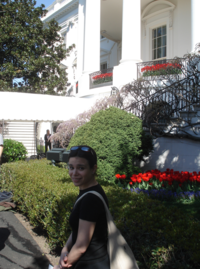Rosemary Braun: Difference between revisions
From Santa Fe Institute Events Wiki
No edit summary |
|||
| Line 1: | Line 1: | ||
==About Me== | ==About Me== | ||
[[Image:Rosemarywh.png|200px|thumb|left|Standing outside the White House.]] Hi everyone. I'm a physicist on paper, but I'm doing systems biology now. I did my physics undergraduate work at Stony Brook (which included an undergrad thesis project simulating the evolution of binary pulsars), and my physics PhD in the [http://www.ks.uiuc.edu/ Theoretical and Computational Biophysics Group] at the University of Illinois, Urbana-Champaign, under the direction of Klaus Schulten, where we used molecular dynamics simulations to understand the behavior of biomolecular systems at atomic- and femtosecond- resolution. After my PhD, I earned MPH (Master of Public Health) at Johns Hopkins, where I worked with Giovanni Parmigiani on a new method for | [[Image:Rosemarywh.png|200px|thumb|left|Standing outside the White House.]] Hi everyone. I'm a physicist on paper, but I'm doing systems biology now. I did my physics undergraduate work at Stony Brook (which included an undergrad thesis project simulating the evolution of binary pulsars), and my physics PhD in the [http://www.ks.uiuc.edu/ Theoretical and Computational Biophysics Group] at the University of Illinois, Urbana-Champaign, under the direction of Klaus Schulten, where we used molecular dynamics simulations to understand the behavior of biomolecular systems at atomic- and femtosecond- resolution. After my PhD, I earned MPH (Master of Public Health) at Johns Hopkins, where I worked with Giovanni Parmigiani on a new method for pathway-based analysis of gene expression data. I'm now a postdoctoral fellow working in the Laboratory of Population Genetics, National Cancer Institute, NIH, under the direction of Ken Buetow. My current work is the development of computational methods for the analysis of data from high-throughput biology experiments -- specifically, methods to summarize the overall behavior of a biological pathway from the data we have about its constituent parts. | ||
pathway-based analysis of gene expression data. I'm now a postdoctoral fellow working in the Laboratory of Population Genetics, National Cancer Institute, NIH, under the direction of Ken Buetow. My current work is the development of computational methods for the analysis of data from high-throughput biology experiments -- specifically, methods to summarize the overall behavior of a biological pathway from the data we have about its constituent parts. | |||
==Answers to Dan's Questions== | ==Answers to Dan's Questions== | ||
Revision as of 13:28, 3 June 2009
About Me

Hi everyone. I'm a physicist on paper, but I'm doing systems biology now. I did my physics undergraduate work at Stony Brook (which included an undergrad thesis project simulating the evolution of binary pulsars), and my physics PhD in the Theoretical and Computational Biophysics Group at the University of Illinois, Urbana-Champaign, under the direction of Klaus Schulten, where we used molecular dynamics simulations to understand the behavior of biomolecular systems at atomic- and femtosecond- resolution. After my PhD, I earned MPH (Master of Public Health) at Johns Hopkins, where I worked with Giovanni Parmigiani on a new method for pathway-based analysis of gene expression data. I'm now a postdoctoral fellow working in the Laboratory of Population Genetics, National Cancer Institute, NIH, under the direction of Ken Buetow. My current work is the development of computational methods for the analysis of data from high-throughput biology experiments -- specifically, methods to summarize the overall behavior of a biological pathway from the data we have about its constituent parts.
Answers to Dan's Questions
- What are your main interests? Feel free to include a "pie in the sky" big idea!
- Generally, I'm interested in abstract models of biological systems, which when paired with data provide biologically meaningful and predictive results. A bit more specifically, I'm interesting in how complex, dynamical, and adaptive biological networks function---or fail to function---ultimately causing the emergence of properties which turn a healthy cell into a cancer cell.
- My pie-in-the-sky idea? I feel that biology is truly on the cusp of something remarkable. We can now easily probe millions of gene expressions/proteins/genetic loci at a time. The wealth of data that is jaw-dropping: we can say with enormous detail how healthy cells differ from tumor cells. On the other hand, most of this data is being analyzed one marker at a time, testing each individual gene (or protein, or SNP) for association with the phenotype. It's easy to lose the forest for the trees this way, particularly when investigating diseases that don't independent causative genes. I think that what biology needs now is something philosophically like stat-mech: a way to abstract away from the fine detail of single genes and instead say something about the bulk properties of the biological networks in which they interact.
- What sorts of expertise can you bring to the group?
- I have physics background and a fair bit of computational physics experience. I also have a good working knowledge statistics/biostats & am a fluent R speaker.
- What do you hope to get out of the CSSS?
- First, I'm looking forward to being with others who are interested in complex systems -- sometimes it seems we're few and far between! I'm interested in deepening (and refreshing) my knowledge of network and nonlinear dynamics, which the ultimate goal of finding new ways to think about biological networks.
- Do you have any possible projects in mind for the CSSS?
- A few vague thoughts, but I'm keeping an open mind.
